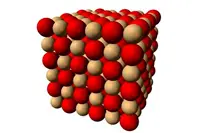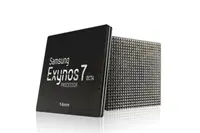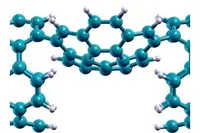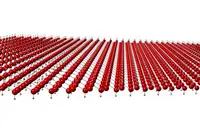Electronics News
Archive : 16 February 2015 год
A material that might be used to create efficient plasmonic devices that respond to light in the mid infrared (IR) range has been identified and synthesised by a team led by North Carolina State University. According to the team, it is the first time such a material has been demonstrated.
 The research focuses on surface plasmon resonance, where the interface between a conducting and an insulating material is illuminated. The team says that, if the angle, polarisation and wavelength of the incoming light are just right, electrons in the conductor begin oscillating. This creates an intense electric field extending into the insulator that can be used in everything from biomedical sensors to solar cells or optoelectronic devices.
The research focuses on surface plasmon resonance, where the interface between a conducting and an insulating material is illuminated. The team says that, if the angle, polarisation and wavelength of the incoming light are just right, electrons in the conductor begin oscillating. This creates an intense electric field extending into the insulator that can be used in everything from biomedical sensors to solar cells or optoelectronic devices.
However, the wavelength of light that causes these oscillations depends on the nature of the conductive material. "There are at least three practical reasons for wanting to identify materials that exhibit surface plasmon resonance in response to mid IR light," says Dr Jon-Paul Maria, a professor of materials science and engineering at NC State. "First, it could make solar harvesting technology more efficient by taking advantage of the mid-IR wavelengths of light; that light wouldn't be wasted. Second, it would allow us to develop more sophisticated molecular sensing technology for use in biomedical applications. And third, it would allow us to develop faster, more efficient opto-electronic devices."
Specifically, the research team has 'doped' cadmium oxide with dysprosium. This does two things: it creates free electrons in the material; and it increases the mobility of the electrons.
"Usually, when you dope a material, electron mobility goes down," Dr Maria says. "But, in this case, we found the opposite – more dysprosium doping increases this critical characteristic."
Author
Graham Pitcher
Source: www.newelectronics.co.uk
 Samsung Electronics has begun mass production of the Exynos 7 Octa, said to be the first mobile application processor to incorporate 14nm FinFET process technology.
Samsung Electronics has begun mass production of the Exynos 7 Octa, said to be the first mobile application processor to incorporate 14nm FinFET process technology.
"Samsung's advanced 14nm FinFET process technology is undoubtedly the most advanced logic process technology in the industry," claimed Gabsoo Han, executive vice president of sales and marketing for Samsung's System LSI Business. "We expect the production of our 14nm mobile application processor to positively impact the growth of the mobile industry by enabling further performance improvements for cutting-edge smartphones."
When compared to Samsung's 20nm process technology, this latest process is said to provide an increase in speed of up to 20% and 35% less power consumption.
Author
Graham Pitcher
Source: www.newelectronics.co.uk
 A team of scientists from Scuola Internazionale Superiore di Studi Avanzati (SISSA) and the University of Zurich believes a carbon molecule called corannulene could help in the development of molecular circuits.
A team of scientists from Scuola Internazionale Superiore di Studi Avanzati (SISSA) and the University of Zurich believes a carbon molecule called corannulene could help in the development of molecular circuits.
Corannulene is a carbon molecule similar in shape to the C60 fullerene – or buckyball. However, where C60 is football like, corannulene has a half spherical configuration.
C60 contains special 'empty states' called buckyball superatom states – or BSS – capable of accepting electrons, but they have very high energies, which makes them difficult to exploit in electronic devices. "In fullerene, the energy levels of the BSS type capable of accommodating 'travelling electrons' are difficult to achieve energetically," said Layla Martin-Samos from SISSA. "Corannullene, on the other hand, seems to be much better suited to the purpose."
Theoretical and simulation based observations show the BSS in corannulene are found at much lower energy levels and can therefore be accessed more easily. "This makes the material an excellent prospective candidate for the construction of electronic circuits" continues Martin-Samos. "In fact, if we put corannulene molecules next to one another in a row, electrons will flow easily from one to the next, forming a sort of tunnel which makes up the circuit."
Author
Graham Pitcher
Source: www.newelectronics.co.uk
 Germanium – used to create transistors in the early days of electronics – is being researched by a number of institutions as a potential replacement for silicon.
Germanium – used to create transistors in the early days of electronics – is being researched by a number of institutions as a potential replacement for silicon.
Germanium – used to create transistors in the early days of electronics – is being researched by a number of institutions as a potential replacement for silicon.
One such project is underway at Ohio State University, where assistant professor of chemistry Joshua Goldberger is working with germanane, a 2D variant of the element. He created a sheet of germanane one atom thick in 2013 and has since been creating hybrid versions of the material, incorporating atoms such as tin across the top and bottom of the sheet,
The goal, says Goldberger, is to make a material that not only transmits electrons 10 times faster than silicon, but which is also better at absorbing and emitting light.
"We've found that, by tuning the nature of these bonds, we can tune the electronic structure of the material," he said. "We can increase or decrease the energy it absorbs so, potentially, we could make a material that traverses the entire electromagnetic spectrum or which absorbs different colours."
Aside from traditional semiconductor applications, it has been predicted that a tin version of the material could conduct electricity with 100% efficiency at room temperature. The heavier tin atom allows the material to become a 2D topological insulator, which conducts electricity only at its edges. Such a material is predicted to occur only with specific bonds across the top and bottom surface, such as a hydroxide bond.
Goldberger's lab has verified that this theoretical material can be chemically stable and created germanane with up to 9% tin atoms. The group is now working on ways to produce pure tin 2D derivatives.
Meanwhile, as they create the various forms of germanane, the researchers are trying to exploit traditional silicon manufacturing methods.
Author
Graham Pitcher
Source: www.newelectronics.co.uk

